
What Happens When You F-Up Your VP of Sales Hire and How to Turn Things Around
What do you think happens when you screw up your VP of Sales hire?
If you think it’s just about hiring a quick replacement while everyone goes on their merry ways, you’re in for a rude awakening.
I can confidently say that messing up your VP of Sales hire is a long, expensive, drawn-out process that hurts your business in more ways than one.
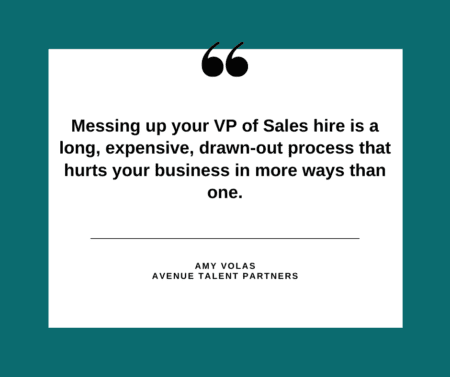
Find yourself in this predicament, and you’ll be blowing through cash, jeopardizing client relationships, affecting your buyer journey, and putting out tiny fires on your team (across the organization) for way longer than you’d care to imagine.
Your VP of Sales hire is mission-critical.
Don’t believe me? You’ll see exactly what happens when you get this hire wrong in today’s guide. You’ll also learn why this type of mistake occurs in the first place (so you can avoid it).
But what if you’re already waist-deep in a mishire mess? How do you get your team out of this calamity with as little collateral damage as possible?
Never fear, I’ve got your back. We’ll wrap up by discussing how to hire the best VP of Sales for your startup so you don’t have to worry about getting this wrong again.
Let’s get the doom and gloom out of the way first.
What Happens When You Get Your VP of Sales Hire Wrong
Hiring a VP of sales for your startup may feel like the deck is already stacked against you.
After all, did you know that the average sales leader in tech only lasts roughly 19 months? With a tenure that continues to shrink (yikes!)?
Jason Lemkin mentioned that, “70% of SaaS First VP Sales don’t make it to 12 months. It’s one of the most common, and almost most devastating mishires in startups.”
Deloitte stated it can cost upwards of 200% on top of what you’ve already spent to replace an employee. That’s wasted time, energy, and money that you can’t get back.
Bad news? This situation is even worse with VP positions.
Losing your VP of Sales is a 7-figure problem I see and hear about firsthand every week. That’s the last thing you want for your growing startup.
Dr. Bradford Smart, the author of Topgrading, discovered that bad hires cost somewhere between 5 to 27 times a person’s salary, as I shared in my cost of a bad hire breakdown.

From what I see, the figures above are conservative and don’t encompass the totality of compensation or disruption.
Hiring costs have gone up significantly, especially within the last six months. We’ve seen it increase by 25% and are hearing the same thing from our Venture partners.
To give you a better idea of some of the hiring costs:
- Time spent preparing a hiring plan and the time spent on the hiring committee
- What it cost you to advertise
- What it costs you to source candidates
- An increase in compensation, this competitive market is white-hot
- The time it cost you to sift through resumes and interviews
- Any assessment, testing, and background checks
- Recruiting fees from external partners like yours truly
- Time spent preparing and delivering an effective onboarding plan
Unfortunately, the cost of a bad hire goes way beyond financial repercussions. This mistake will also:
1. Set Your Business Back
Forbes stated that it can take eight to 12 weeks to replace a typical knowledge worker and one to two months before someone can really get up to speed and start producing meaningful work in their place.
That’s a total of 20 weeks!
Now imagine how much longer this is for a VP of Sales.
From what I see, this sets your business back by at least six months. I talked to a Founder recently that was looking for help as they were unable to find the VP of Sales for their startup… they had interviewed 46 people over 9 months.
Think about all the progress your team has made leading up to this hire. If you end up with the wrong person doing the wrong work, it’ll be like taking a giant eraser and wiping it all away.
Would you be ready to start over? Would your team or investors be happy? What experience would you be creating for your buyers? How does this affect your ability to hire the right person moving forward?
Don’t answer those; I’ll mark your answers as heck no or not very good.
2. Jeopardize Your Buyer Journey and Customer Experience
Hiring the wrong VP means your customer and buyer journey will also suffer.
With each shuffle of a new VP of Sales, there will be slight changes felt by your customers throughout the process.
These changes, regardless of how small they may be, won’t go unnoticed. Put your customers through them enough times, and your lack of consistency will definitely turn them away and earn you a bad rap.
Customer experience matters!.. Without them or a strong pipeline, you don’t have a business.
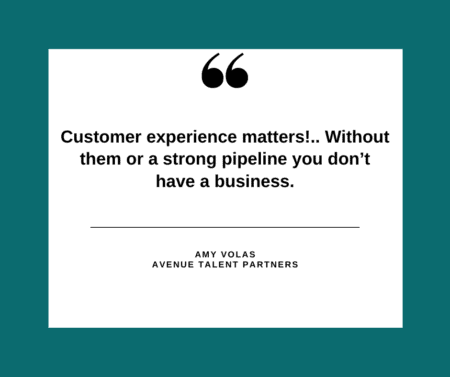
3. Disrupt the Team (and Not In a Good Way)
A lack of consistency is alarming for customers, but it’s also terrible for your team.
Depending on how long a VP of Sales sticks around, your team may not have time to test some of their new strategies.
So once they leave, your team will either need to scramble to go back to the old ways or take a chance on running a process someone helped facilitate yet won’t be able to implement, finesse, or support.
Having to change game plans so often like this fatigues your team, leading to burnout. It creates unnecessary stress that impacts the quality of their work, which you want to avoid.
Additionally, if your sales team is worried about who they’ll be working under next while questioning your ability to hire a good sales leader. The inconsistencies and unknowns may encourage them to find greener pastures somewhere with more stability.
And the statistics prove this happens often:
- The average sales turnover is 35%, which is 23% higher than the 13% average for other industries
- To replace a sales rep, it could cost you between 150 to 200% of their salary
- It can take you at least six months to fill their position
- Hiring a sales leader is the hardest hire to make for startups (complements of First Round):

The truth is, oftentimes when a leader leaves, there are going to be team members that follow them. Especially the people they hired directly or followed them over to work with them again.
This creates a domino effect where one bad mishire leads to more people jumping ship and painful compounding consequences.
You run the risk of eroding the rest of your team’s confidence cross-functionally too. They may start to question your leadership choices, they’re ability to be successful if Sales is suffering, tanking your company’s morale and momentum.
I think we can agree that it’s not worth it to put your startup through hiring the wrong VP of Sales.
Since it pays to get this hire right the first time, why do so many companies end up making this costly mistake?
Why a Bad VP of Sales Hire Happens in the First Place
In my experience, there are usually four mistakes that lead to hiring the wrong VP of Sales:
1. Founders Have Unrealistic Expectations on the Table
Look, you can only sell something the market wants and responds to; it will always speak louder than you can. Without product-market fit, you won’t be able to scale.

So are you listening to the market and setting realistic expectations? Or are you expecting your VP of Sales to somehow magically transform the situation for you?
If it’s the latter, it’s not going to happen.
You have to be realistic about your place in the market, products, what you’re offering, what you’re able to deliver, what you’re looking to achieve, and the work that needs to be done for where your startup is today and the near term. Only then can you make sure you have the right leader in place to help you reach your goals.
Anything less than this means you exponentially increase your risk to botch this critical hire.
So before you decide to start hiring again, give your business a reality check to see what’s truly feasible.
And whatever you do, do not hire for future state and your end game. That’s a completely different ball of wax with a plethora of milestones and different work that needs to be done to get to that point. It’s also one of the most common missteps I see Founders make.
But Founders aren’t the only ones with the wrong expectations…
2. There Are Unrealistic Expectations from Potential Candidates
Interviewing is like dating. It’s easy for candidates to hear what they want to while getting caught up in your story and all of the glorious things you’re wanting to accomplish. Because of that, they may have rose-colored glasses on, causing them to struggle to dig below the surface.
But if they’re not clear on their superpowers and don’t quantify or qualify what they’re looking for, then they’ll get stuck on what it could be like working with you instead of what it’s really like in practice.
This is another recipe for mishire disaster.
But how can you fix this if it’s candidate-driven?
I’ll show you exactly how to do this later on in this guide but, before I do, there are a few more mistakes you’ll want to avoid that should be discussed first:
3. Founders Accidentally Follow Bad Advice
Another cold hard truth? Advice you read or hear may not apply to your startup — even if it’s supposedly the best advice for SaaS companies.
There’s a difference between advice, context, and competence.
We’re not living in a one-size-fits-all world. So even if you’re taking general SaaS advice from the most trustworthy sources, you could still be doing your business a huge disservice.
The reality is that no one knows your business as you do. And that means you need to think carefully and critically about the advice you want to put into practice long before you actually follow through on it.
Think first to understand the why, what, how, so what, when, and where to then consider all the ways this advice could work and harm your business. Look at both sides of the coin.
While you may hope this advice improves things, it will only cause more problems if it’s wrong for your startup.
This also leads to the next common mistake:
4. You Fell for a Referral That Didn’t Work Out
I get it. Your board was on your back to hire their referral — who they swore could help turn things around — and you succumbed to their pressure.
You’re not alone. We’re currently engaged on a search to help the Founder clean up after a mishire. The former VP of Sales was a recommendation from the board that came from a big company with big promises to boot. Only to fall short as they were more of a “maintainer” versus a “builder” and got in way over their head.
It’s tempting, you want to keep everyone happy, especially when the pressure is on or you truly believe that the board referral is the golden ticket. Without an intentional hiring process, you’re likely to realize after the fact that the referral isn’t all they’re cracked out to be, and now you’re in trouble.
I see this mistake so often, and it rarely works out well. You can’t hire well without validating what you need first.
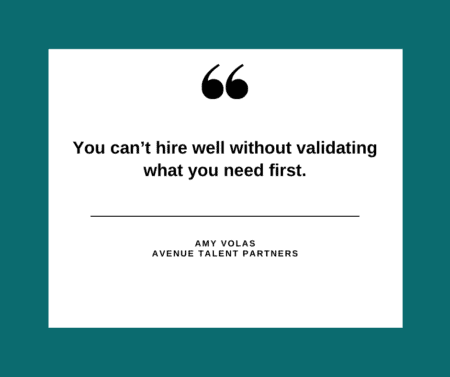
This recipe for disaster not only results in the three repercussions of a bad hire we discussed earlier, but creates unnecessary friction between you, your board members, and the person that didn’t work out.
As the Founder, you have a voice, this is your business, and you’re entitled to pushback, especially if this person has no business considering your role.
So never accept a referral without thinking first to validate if it makes sense for your stage and the task at hand.
How to Get Hiring a VP of Sales Right Once and For All
There are four key ingredients to getting your VP of Sales hire right the first time around. Keep these tips in mind, and you can focus on growing your startup without the worry about making a bad hire ever again:
1. Always Be Intentional
Now’s the time to roll up your sleeves and get super specific about what you need in a VP of Sales. Just because someone has fancy titles and woos you during the interview doesn’t mean they’re a good fit.
So how do you narrow down who might be?
Start answering these questions before the hiring process:
- Why are you hiring in the first place?
- What’s the biggest problem you need to solve right now?
- What does your business specifically need right now? What about a few months or years from now?
- What’s the market telling you?
- What stage is your business in? Where do you hope to take it in the next few weeks, months, and years?
- What do the next two years look like?
Even though some of these questions involve a bit of projecting into the future, you don’t want to hire someone today for your 10-year plan. If they can’t work on your short-term problems, they’ll never have a chance to make it to your long-term ones.
And, honestly, your business may not either.
So while it pays to think about your team’s future, you shouldn’t hire so far out that this person misses your goals in the present.
Another factor to consider is understanding what potential VPs are looking for in your company.
It turns out, there’s a big gap between what employers think matters to their employees and what employees actually want, as the McKinsey graph below points out:
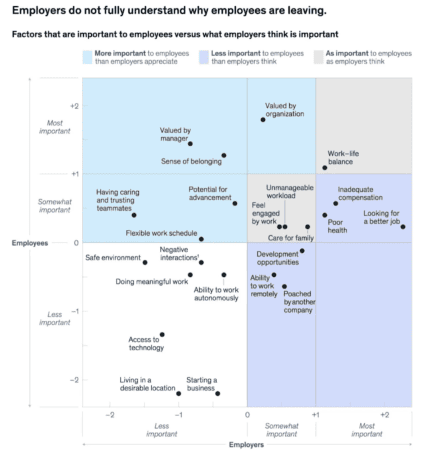
Because of that, if you’re not also focusing on valuing your VP of Sales once you hire them, you don’t create a sense of belonging or show that you trust and care for them, there’s a good chance you’ll be back to the drawing board soon and this cycle could easily repeat itself.
To prevent that from happening, you need to be more intentional about what you’re looking for in a VP and how you plan to treat them once they’re hired.
Once you answer the questions and consider the points mentioned in this section, you’ll naturally get more intentional about who you want to hire and how you’ll treat them once they’re onboard, which puts your business in a much better position to make the right call and keep your VP for more than 19 months to come.
2. Know What Good Leadership Looks Like
On top of knowing what you need, it’s also crucial that you learn how to spot a good leader when you see one. This is something many Founders think they know how to do but sadly struggle to get right.
In a nutshell, here’s what world-class startup leadership looks like:
- Someone who creates psychological safety. This is the ability to create an environment where people freely express their thoughts without fearing criticism or negative consequences. Hiring anyone who fails to do this is a huge mistake.
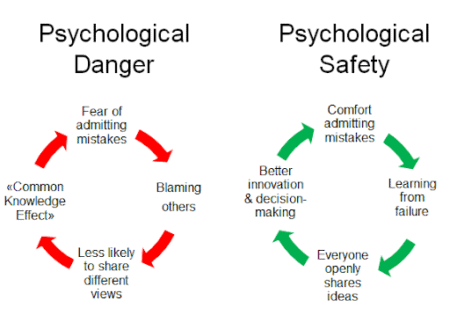
Great leaders realize it starts from the top down. They create a culture of transparency and accountability so their team can share their views without fear of repercussion. They know that’s how people inspire innovation and produce their best work.
This transparent, open environment brings out the best in people. And that makes it a must-have quality for any VP of Sales you interview.
- Someone who’s a master listener. One of the keys to creating that psychological safety is the ability to listen.
We often take being a good listener for granted, but it makes all the difference between average leaders and exceptional ones.
When people know their voice is being heard, they’re more likely to speak up and share their opinions, which encourages brilliant ideas every startup needs.
On the flip side, if your team members know your VP isn’t really listening to them, they’ll contribute less and quickly lose interest, meaning your VP won’t be the only one you have to replace.
Ultimately, people want to be seen, heard, and understood. The only way to do this well is to listen to understand NOT respond.
- Someone who’s an incredible communicator. How well your VP listens is only half the battle. You also need them to clearly communicate their thoughts, passion, direction, and ideas to get other employees excited to jump on board and stay the course… up, down, and across the company.
Stellar communication skills also help ease tense situations and motivate people out of a slump. They can even get other employees to communicate better to boost collaboration.
- Someone with an unwavering vision and a plan to make it happen. Strong leaders know where they’re going and what needs to get done to do it well together, for the long haul. But they don’t just keep it bottled up inside their brain.
Innovative leaders clearly paint the picture of their vision for everyone else and outline all the steps you and your team need to accomplish it. They are masters when it comes to galvanizing people together to hunker down to get down to business to move the needle.
They know precisely what it takes for everyone to “buy into” and share this vision, getting people excited about the “why” and the “how.” This is essential when times inevitably get tough and people start doubting the process.
These are four of my top attributes VPs should hold at a minimum.
3. Make Sure Your VP of Sales Has These Top Traits
On top of must-have leadership attributes, you’ll also want to keep the top traits to look for in a VP of Sales on your radar. And you’ll need to compare these with a fine-toothed comb when it comes to what your startup needs.
For example, there’s a difference between a VP specializing in deal management versus one who excels in process management. If you hire the wrong one, you won’t get the help where you need it most.
So make sure a candidate’s expertise and experience fill in the gaps of what your team lacks but desperately needs.
Additionally, look for a VP who:
- Is aligned with your mission and the work that needs to be done to succeed
- Is multi-dimensional
- Is resilient
- Puts people first
- Holds themselves accountable
- Doesn’t crack under pressure
- Has strong emotional intelligence
- Knows how to hire, onboard, support, and retain their team
- Has the “will”, “skill”, and is leaning in
This is just the top of the traits iceberg, more can be found here.
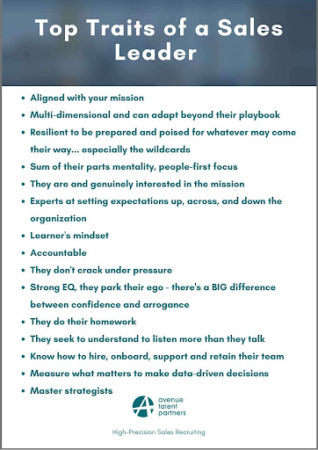
If you’re not properly vetting your VPs to ensure they have these must-have traits, you’re rolling the dice and headed for a choppy road ahead.
One surefire way to avoid making this mistake is to:
4. Always Use a Hiring Scorecard During Interviews
If you aren’t familiar with a hiring scorecard (gasp!), it’s an unbiased system that helps you evaluate candidates based on a set of standards and qualifications you’re looking for.
When you create your hiring scorecard, you’ll list all the traits and experience you want your ideal hire to have. During your interviews, this will be your “North Star” to ensure you dig into the appropriate nooks and crannies. It will help you evaluate and score each candidate on how well they meet those qualifications.
It’s easy to get caught up in the stories we tell ourselves throughout the hiring process. These scores help you get you out of your own way to measure what matters the most.
It’s a powerful visual to help you uncover which candidates make the most sense for your startup, not just those who look good on paper or interview well. It’s like taking off your rose-colored glasses to see the candidates who actually fit your needs.
Using a hiring scorecard narrows down exactly what your startup’s looking for (which helps you become more intentional). It also gives you the ability to ask deeper, probing questions during your interviews to dig well below the surface.
And because you’re vetting each candidate so thoroughly using an unbiased system, you’ll naturally reduce your time to hire and churn rate. Say adios to messy gut-feels clouding your judgment!
A hiring scorecard is a powerful tool that I cannot recommend enough and use with every single one of my clients.
Overwhelmed? Don’t be, it’s easy to create and use one when you read this guide.
Final Thoughts
If you’ve made the mistake of hiring the wrong VP of Sales for your startup, all is not lost! When you embrace the steps above, you’ll be drastically reducing your error for getting this hire wrong again.
Finding the right person will be a heck of a lot easier and you’ll be closer to reaching the critical milestones ahead.
Recruiting a sales leader who’s capable of taking your business to the next level rather than fruitlessly trying to jam a square peg into a round hole is the name of the game.
After all, if you’re truly ready to grow, you cannot afford to F-up this crucial hire.
